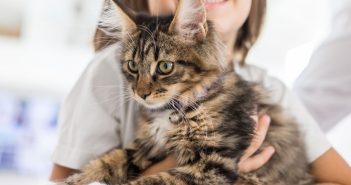Patterns are a mixture of colors in a definite arrangement. The six fundamental types of coat patterns present in cats with some differences are Tabby, Tortoiseshell, Solid, Bicolor, Colorpoint and Tricolor.
1. Tabby: This coat pattern is the most widespread found naturally and is present in four varieties: blotched (marbled), striped (mackerel), ticked (agouti) and spotted.
2. Tortoiseshell: An unswerving blend of black and orange or thinned shades of blue and cream form this exclusive coat pattern. This coat pattern is a tricolor present almost uniquely in females with a blend of orange and black. Male cats rarely show this pattern and are likely sterile. These cats also show an inner tabby pattern called as “torbie”.
3. Solid: This pattern is the easiest and identifiable one, as it consists of a single coat uniformly spread throughout the body. An interesting solid pattern with hair of different color is seen in young cats. The secondary colored hair vanishes as the cat grows and very soon, the cat displays a solid hairy pattern all over. It is not possible to acknowledge a cat that has a spot of some other color on its coat, as a solid. People generally refer cats with a solid pattern as “self’s” or “self-colored”.
4. Bicolor: The word bicolor is actually a white-colored coat along with another color. The other color displays a tabby or a solid pattern. People commonly describe a cat with a white colored coat as a harlequin. “Van” is the term describing a definite variation in which the feline is white colored, with spots of color present only on the tail and head. Names are given for the patches of white present on a bicolor cat, which express their positions such as mittens (paws), locket (chest), and buttons (patches on the abdomen).
5. Colorpoint: The paws, face and tail (points/tips) are dark in color in comparison with the rest of the body in this coat pattern. The colorpoint pattern mainly depends on temperature. The hotter body parts show a lighter color and vice versa. The dissimilarity between the main body color and the spots differ, but this coat pattern is very easily recognizable. The spots are present in varied shades and colors containing red (flame), brown (seal), lilac and blue. In some varieties, generally, the spots have a tabby pattern or a tricolor pattern containing the above-mentioned colors. “Lynx” is the term used to describe colorpoints having a tabby pattern.
6. Tricolor: The main color components of the tricolor coat patterns are black, white, orange and red or thinned shades of blue and cream. The proportion of the color and white displays the number and position of the shades of the additional two colors. If there is some amount of white, the remaining two colors may combine to form a pattern called as a “tortoiseshell and white”. The patches of black and red become visibly distinct, as the white color increases. Calico is the term used for this type of coat pattern in cats.

Go to Cat and Kitten Zone to get your free ebook about Cats and Kittens at Cats. Cat and Kitten Zone also has information on Kittens, Cat Supplies and a Cat and Kitten Forum where you can connect with others who love cats and kittens. You can Find Cat and Kitten Zone at www.catandkittenzone.com.




1 Comment
It is worth noting that the reason tortoiseshells are almost invariably female is because the colour genes are sex-linked, and for this particular colour combination the cat needs two X chromosomes – i.e. it must be female. One X will be black, one X will be ginger. In each cell X inactivation randomly occurs, such that on average 50% of cells have the black phenotype and 50% have ginger.
KittenGuru.com